Best of Middle Grades Science Activities
The ScienceNspired.com website is an excellent resource for any science teacher looking for lessons and content that can be used either in person or online. The colorful and engaging simulations help bring the concepts to life for students by enabling them to test variables and challenge their own ideas. Take a look at some of the best middle grades science activities below. These are just a few of the many activities available for free with your TI-Nspire™ CX Premium Teacher Software or TI-Nspire™ CX or TI-Nspire™ CX II graphing calculator. Don’t have the software? Click here to get started.
1. Skills of Science: Building and Interpreting Graphs
This is a great activity to help students learn about using graphs to represent the results of experiments and observations. It’s a great resource for students new to graphs or who need a little review.
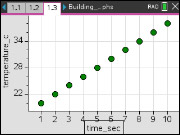
Earth and space science topics
2. Earth’s Surface: Earth’s Lithosphere — Ring of Fire
This activity takes students on a journey around the Pacific Rim and the infamous “Ring of Fire.” Students will plot locations of earthquakes and volcanos to see if any pattern emerges.
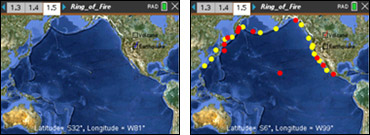
3. Earth’s Water: Fresh Water — The Water Cycle
Students will explore all components of the water cycle in this straightforward simulation. In addition, they can change global temperatures to see the effect on ocean levels.
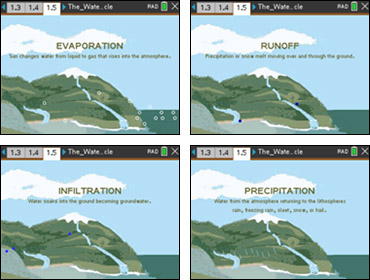
4. Space: Lunar Phases — It’s Just a Lunar Phase
It’s hard to study the phases of the moon in a couple of class sessions when it takes about a month for the moon to cycle. A great alternative is to use a simulation. It’s Just a Lunar Phase will enable students to observe the positions of the moon relative to Earth and the sun over months, as well as observe each of the phases.

Life science topics
5. Cells and Heredity: Cells — Cell-ebrating Life
This is a great introduction to cells and organelles. Students take a voyage into both animal and plant cells and get an in-depth look at the organelles within. They will see similarities and differences between both cell types.
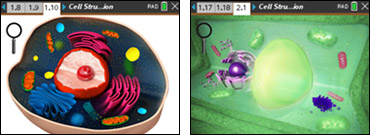
6. Ecology: Biodiversity — Some Like It Hot
Your students will dive head first into this virtual aquatic ecosystem to observe effects of temperature and pH changes on the diversity of fish.

7. Classification of Life: Needs of Living Things — Photosynthesis in Plants
Students will explore the relationship between the visible light spectrum and photosynthesis in this illuminating lesson. Students control the wavelength of light with a clicker, and they can see how the stomata in a leaf respond. They may be surprised by what they find.
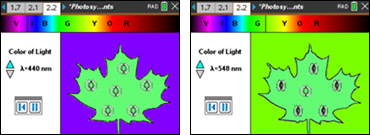
Physical science topics
8. Forces and Motion: Kinetic and Potential — Energy Skate Park (MG)
Students will experiment with kinetic and potential energy of a virtual skateboarder on an adjustable half-pipe. They can then see how things change when gravity changes, such as on the moon or on Jupiter.

9. Properties of Matter: Atoms and Molecules — Build an Atom (MG)
Students will use a simulation that allows them to build atoms with virtual neutrons, protons and electrons. Based on their components, they will observe the stability of their new creations, as well atomic mass and numbers.
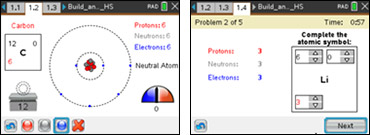
10. Energy: Heat Absorption and Color — Color and Heat
This simulation lets students pick the color of a virtual plate attached to a thermometer. When students shine a light on the plate, the thermometer records the amount of heat energy absorbed by the plate color.

About the author: Erick Archer is a Market Strategy Manager at Texas Instruments and works with science and STEM teachers in the implementation of TI technology. He is also a former high school science teacher, father of two sons, married to his high school sweetheart and LOVES baseball.
Tags:
- life science
- physical science
- earth and space science
- photosynthesis
- light intensity
- stomata
- kinetic
- potential
- energy
- ring of fire
- earthquake
- volcano
- lithosphere
- water cycle
- precipitation
- evaporation
- condensation
- runoff
- infiltration
- water shed
- moon phases
- waxing
- waning
- gibbous
- crescent
- plant cell
- animal cell
- eukaryotic
- organelles
- mitochondria
- endoplasmic reticulum
- ribosomes
- nucleus
- nucleoli
- lysosome
- chloroplast
- cell wall
- cell membrane
- golgi body
- cytosol
- centriole
- biodiversity
- atom
- proton
- neutron
- electron
- atomic number
- atomic weight
- atomic mass
- ion
- absorption
- radiation
Tagcloud
Archive
- 2025
- 2024
- 2023
- 2022
-
2021
- January (2)
- February (3)
- March (5)
-
April (7)
- Top Tips for Tackling the SAT® with the TI-84 Plus CE
- Monday Night Calculus With Steve Kokoska and Tom Dick
- Which TI Calculator for the SAT® and Why?
- Top Tips From a Math Teacher for Taking the Online AP® Exam
- Celebrate National Robotics Week With Supervised Teardowns
- How To Use the TI-84 Plus Family of Graphing Calculators To Succeed on the ACT®
- AP® Statistics: 6 Math Functions You Must Know for the TI-84 Plus
- May (1)
- June (3)
- July (2)
- August (5)
- September (2)
-
October (4)
- Transformation Graphing — the Families of Functions Modular Video Series to the Rescue!
- Top 3 Halloween-Themed Classroom Activities
- In Honor of National Chemistry Week, 5 “Organic” Ways to Incorporate TI Technology Into Chemistry Class
- 5 Spook-tacular Ways to Bring the Halloween “Spirits” Into Your Classroom
- November (4)
- December (1)
-
2020
- January (2)
- February (1)
- March (3)
- April (1)
- May (2)
- July (1)
- August (2)
- September (3)
-
October (7)
- Tips for Teachers in the time of COVID-19
- Top 10 Features of TI-84 Plus for Taking the ACT®
- TI Codes Contest Winners Revealed
- Best of Chemistry Activities for the Fall Semester
- Best of Biology Activities for the Fall Semester
- Best of Physics Activities for the Fall Semester
- Best of Middle Grades Science Activities
- November (1)
- December (2)
- 2019
-
2018
- January (1)
- February (5)
- March (4)
- April (5)
- May (4)
- June (4)
- July (4)
- August (4)
- September (5)
-
October (9)
- Art in Chemistry
- Which Texas Instruments (TI) Calculator for the ACT® and Why?
- Meet TI Teacher of the Month: Jessica Kohout
- Innovation in Biology
- Learning With Your Students
- A first-of-its-kind STEM strategy charts path to help educators
- #NCTMregionals Hartford 2018 Recap
- The Math Behind “Going Viral”
- Real-World Applications of Chemistry
-
November (8)
- Testing Tips: Using Calculators on Class Assessments
- Girls in STEM: A Personal Perspective
- 5 Teachers You Should Be Following on Instagram Right Now
- Meet TI Teacher of the Month: Katie England
- End-of-Marking Period Feedback Is a Two-Way Street
- #NCTMregionals Kansas City 2018 Recap
- Slope: It Shouldn’t Just Be a Formula
- Hit a high note exploring the math behind music
- December (5)
- 2017
- 2016
- 2015
